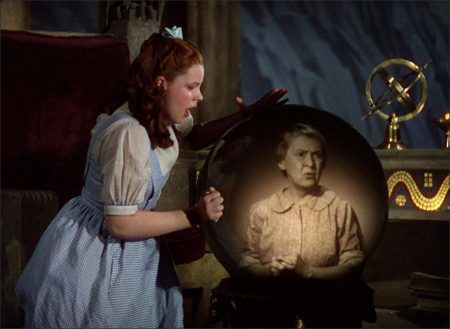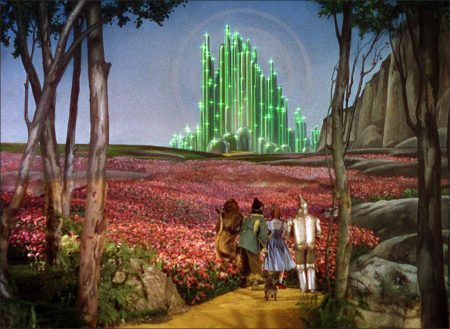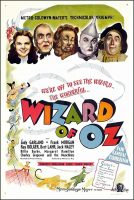The Wizard of Oz (1939) is everybody’s cherished favorite, perennial fantasy film musical from MGM during its golden years. For many seasons, it was featured regularly on network TV as a prime time event (its first two showings were on CBS television on November 3, 1956 and in December, 1959) and then annually for Thanksgiving, Christmas and/or Easter time.
It soon became a classic institution, and a rite of passage for everyone, and probably has been seen by more people than any other motion picture over multiple decades. Initially, however, the film was not commercially successful (at $3 million), but it was critically acclaimed.
All of its images (the Yellow Brick Road, the Kansas twister), characters (e.g., Auntie Em, Toto, Dorothy, the Wicked Witch), dialogue (e.g., “Lions and tigers and bears, oh my!”, “We’re not in Kansas anymore,” “Follow the Yellow Brick Road,” or the film’s final line: “There’s no place like home”), and music (“Over the Rainbow”) have become indelibly remembered, and the classic film has been honored with dozens of books, TV shows (such as HBO’s dramatic prison series Oz), references in other films, and even by pop groups (singer Elton John with his Goodbye, Yellow Brick Road album, or Pink Floyd’s 1973 album Dark Side of the Moon).
The film’s plot is easily condensed: lonely and sad Kansas farmgirl Dorothy dreams of a better place, without torment against her dog Toto from a hateful neighbor spinster, so she plans to run away. During a fierce tornado, she is struck on the head and transported to a land ‘beyond the rainbow’ where she meets magical characters from her Kansas life transformed within her unconscious dream state. After travels down a Yellow Brick Road to the Land of Oz, and the defeat of the Wicked Witch of the West, Dorothy and her friends are rewarded by the Wizard of Oz with their hearts’ desires – and Dorothy is enabled to return home to Kansas.
The Wizard of Oz is a 1939 American musical fantasy film produced by Metro-Goldwyn-Mayer. Widely considered to be one of the greatest films in cinema history, it is the best-known and most commercially successful adaptation of L. Frank Baum’s 1900 children’s book, The Wonderful Wizard of Oz. It was directed primarily by Victor Fleming (who left production to take over direction on the troubled Gone with the Wind production). It stars Judy Garland as Dorothy Gale, alongside Ray Bolger, Jack Haley, Bert Lahr, Frank Morgan, Billie Burke and Margaret Hamilton, with Charley Grapewin, Pat Walshe and Clara Blandick, Terry (billed as Toto), and the Singer Midgets as the Munchkins.
Legendary for its use of Technicolor, fantasy storytelling, musical score, and memorable characters, it has become an icon of American popular culture. It was nominated for six Academy Awards, including Best Picture, but lost to Gone with the Wind. It did win in two other categories, including Best Original Song for “Over the Rainbow” and Best Original Score by Herbert Stothart. While the film was considered a critical success upon release in August 1939, it failed to make a profit for MGM until the 1949 rerelease, earning only $3,017,000 on a $2,777,000 budget, not including promotional costs, which made it MGM’s most expensive production to that time.
The Wizard of Oz (1939)
Directed by: Victor Fleming, King Vidor, George Cukor, Norman Taurog
Starring: Judy Garland, Frank Morgan, Ray Bolger, Bert Lahr, Jack Haley, Billie Burke, Margaret Hamilton, Charley Grapewin, Pat Walshe, Clara Blandick, The Singer Midgets, Josefine Balluck
Screenplay by: Noel Langley, Florence Ryerson, Edgar Allan Woolf
Cinematography by: Harold Rosson
Film Editing by: Blanche Sewell
Costume Design by: Adrian
Set Decoration by: Edwin B. Willis
Art Direction by: Cedric Gibbons, George Gibson, Wade B. Rubottom, Elmer Sheeley
Music by: Herbert Stothart
MPAA Rating: PG for some scary moments.
Distributed by: Metro-Goldwyn-Mayer
Release Date: August 25, 1939
Views: 241








